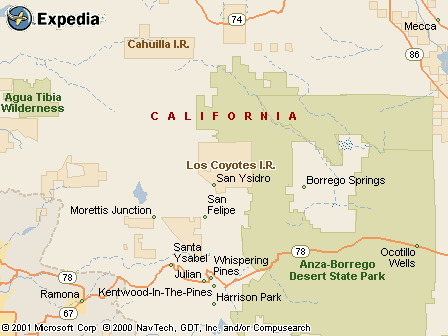|
|
Canku Ota |
|
|
(Many Paths) |
||
|
An Online Newsletter Celebrating Native America |
||
|
August 25, 2001 - Issue 43 |
||
|
|
||
|
Academy Restoring Ancient Links |
||
|
by Chet Barfield Staff Writer Signs on San Diego - August 14, 2001 |
 LOS COYOTES
INDIAN RESERVATION -- It's a muggy August afternoon, and 14 teens from five North County reservations are climbing
a ridge high above Lake Henshaw. LOS COYOTES
INDIAN RESERVATION -- It's a muggy August afternoon, and 14 teens from five North County reservations are climbing
a ridge high above Lake Henshaw.Although they laugh and joke around, these youths are on a serious mission for Indian tribes throughout the county. They're looking for the right spot to put one in a network of wireless Internet antennas. As part of a summer training program, tribal youths have a key role in bringing the World Wide Web to San Diego's 18 reservations. This is the "tribal digital village" project. Funded by a $5 million grant from the Hewlett-Packard Co., it's providing equipment, training and high-speed Internet access to the reservations, some of which -- like Los Coyotes -- are extremely remote. Through relays with "backbone" antennas, the region's tribes for the first time will be linked to each other and to the Supercomputer Center at the University of California San Diego. The aim is to restore connections these bands had in aboriginal times, and bring them to the forefront of new technology, said Ross Frank, a UCSD ethnic studies professor who wrote the grant application on behalf of the Southern California Tribal Chairmen's Association. The Internet offers lots of ways for tribal communities to make new strides and revive ancient culture. Language classes, online tribal meetings and Web sites for native artisans are some examples. Three North County reservations got plugged in under a similar program last year. Antennas for the rest will go up over the next six months. Each must be mounted with a line-of-sight view of at least one other antenna. And that's where the teens come in. In a summer training academy funded by the grant, 28 youngsters from North and East county reservations have been learning computer technology and helping build the digital network. If young people have a stake in the system, organizers reasoned, they'll be more likely to use it when it comes online. And that enthusiasm might ripple out to family, friends and throughout tribes. Meeting four days a week since July 2, the academy youths have visited the Supercomputer Center, learned how to create Web pages and been taught how to use high-tech global positioning systems (GPS) and geographic information systems (GIS). And they've been hiking reservation hills at least once a week. For this they get a stipend of $7 an hour, plus three units of high school or college credit. At Los Coyotes last week, 14 teens and three instructors climbed a quarter-mile up a steep, brush-covered rise. One of the boys, Greg Lovett of San Pasqual, took readings on a hand-held global-positioning unit the size of a cellular phone. He relayed the coordinates to an instructor, who tapped them into a laptop computer equipped with GIS software to display a topographical map of the area. "I didn't know how to use that stuff before," said Lovett, 17. The teen-ager and his classmates have been keeping journals of what they have learned at the summer academy, which will end Friday. Some of their journals and photos are being posted on a tribal Web site, Kumeyaay.com. These young people will help lead their reservations into the information age, said Jack Ward, project coordinator for the tribal chairmen's association. "We wanted to give them an enriched program that goes beyond just finding sites and getting a compass reading," Ward said. "We wanted them to get a flavor of the whole technology, because one of the objectives of the grant is when Hewlett-Packard goes away, we will have people in the tribes who are trained to use this thing." |
|
|
|
Tribal Digital Village Project |
|
|
||
|
|
||
| Canku Ota is a free Newsletter celebrating Native America, its traditions and accomplishments . We do not provide subscriber or visitor names to anyone. Some articles presented in Canku Ota may contain copyright material. We have received appropriate permissions for republishing any articles. Material appearing here is distributed without profit or monetary gain to those who have expressed an interest. This is in accordance with Title 17 U.S.C. section 107. | ||
|
Canku Ota is a copyright © 2000, 2001 of Vicki Lockard and Paul Barry. |
||
|
|
|
|
|
The "Canku Ota - A Newsletter Celebrating Native America" web site and its design is the |
||
|
Copyright © 1999, 2000, 2001 of Paul C. Barry. |
||
|
All Rights Reserved. |
||

